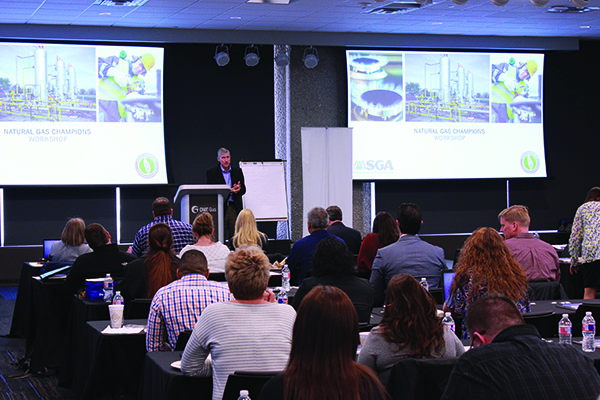June 2018, Vol. 245, No. 6
Features
SGA Chair Caron Lawhorn on a Mission to Raise Industry’s Voice
By Jeff Awalt, Executive Editor
Caron Lawhorn knows a thing or two about transformation. The Dallas native became an Oklahoman more than 40 years ago, opting to make it her home after graduating from the University of Tulsa. She started her career in public accounting and joined ONEOK as an auditor, then made the leap to operations as head of its natural gas distribution business unit in 2011. She even transformed ONEOK’s four-year Transformation Program when it spun off its distribution business as ONE Gas midway through the program.

As 2018 chair of the Southern Gas Association (SGA), Lawhorn has even bigger changes in mind. The senior vice president of ONE Gas’ Commercial division is on a mission to give the entire natural gas industry a bigger voice in the national conversation on energy efficiency and sustainability.
“It’s become clear to me and to many others in our industry that natural gas is getting lost in the conversation about the future of energy in America. As our country continues to focus on reducing greenhouse gas emissions, there’s a growing voice proclaiming that electrification is the means to that end,” Lawhorn said.
“We believe that natural gas has an essential place in our energy future, and it is not inconsistent with a goal of reducing greenhouse gas emissions,” Lawhorn added. “The use of natural gas has increased dramatically, and greenhouse gas emissions have fallen. As an industry, we need to raise our voice and make sure natural gas is in the forefront of that conversation.”
Lawhorn isn’t the first to voice those concerns. The difference is, she’s bringing along an innovative program to help address them.
Sharper Focus
Dallas-based SGA filled some important staff positions before starting 2017 with a new president and CEO, William Cantrell, but it hadn’t gone through a strategic planning process in a couple of years. During that time, the public discourse on pipelines and fossil fuels turned sharply more negative as the impact of media-savvy opposition caught much of the industry by surprise. It was time to take a deep dive into SGA’s mission and vision, priorities and strategy.
As first vice chair of SGA’s board last year, Lawhorn helped lead the strategic planning process, which produced a refined vision statement, “Engaging the natural gas industry for a sustainable tomorrow.” The theme Lawhorn selected for her year as 2018 chair reflects both SGA’s vision and her message to policymakers, regulators and the public: “Natural gas makes sense … For today and for the future.”
“The SGA is still pursuing its mission – ‘Linking people, ideas and information’ – by bringing people together through roundtables and conferences to collaborate and share best practices and to provide technical training. That hasn’t changed,” Lawhorn said.
“But what has changed is this realization that natural gas is going to get left behind if we don’t start getting the message to policymakers, regulators and the public about the benefits and about the role of natural gas,” she added.
Unlike many industry associations, SGA does not engage in lobbying or other political activities, but a program to build public awareness and support would be true to its mission.
Creating Champions
Around the time SGA was considering how to help its member companies respond to growing industry opposition, the American Gas Association (AGA) and the Interstate Natural Gas Association of America (INGAA) were also starting to address this challenge. The organizations conducted a series of focus groups and surveys to gain a better understanding of public perception and how it is influenced.
The results showed employees and experts such as scientists, engineers, safety specialists and pipeline workers are among the most credible people to deliver the natural gas message. With its expertise in training, SGA saw an opportunity to mobilize this workforce to help reclaim the public narrative.
“The natural gas distribution business has hundreds of thousands of employees across the country – and who better to advocate for our product than our employees,” Lawhorn said. “As we started considering what our training goals might be, in the simplest terms, we wanted them to be informed and comfortable with having what can sometimes be challenging conversations about natural gas.”
Working in collaboration with AGA and INGAA, who saw it as a complementary addition to their own programs, SGA started developing the “Natural Gas Champions” program. ONE Gas and three other SGA member companies – WGL, NiSource and Atmos – became early supporters and piloted the program before SGA offered the first training module at its Spring Gas Conference and Expo. Additional training modules are due out this summer, and SGA will offer the training again at its fall Marketing, Customer Experience and Communications Conference.
“We trained our entire Business and Cultural Development Group on this first module, and the feedback has been very positive,” Lawhorn said. “Our employees are very excited that we’re getting engaged in the conversation.”
Improving Diversity
In addition to helping the industry gain a more prominent voice and greater public support, SGA remains focused on diversity. Last year was the first time SGA had a female chair, and Lawhorn immediately followed as the second. That’s a sign of progress, she said, but the industry still has farther to go.
“I don’t think the playing field is level yet, but our industry has certainly made considerable strides,” she said, noting that the ability to reach full parity for women and minorities is to attract more of them into the STEM fields – science, technology, engineering and math – and then into the industry.
Lawhorn said she’s proud of SGA’s role in driving awareness of inclusion and diversity. Now in its fourth year, the association’s Women in Leadership Forum has become so popular that it will be offered twice a year. Lawhorn will be a keynote speaker when ONE Gas hosts the event this fall at its headquarters in Tulsa.
“More companies want to send their employees to these programs, because they recognize that bringing more women into leadership positions is good for business,” she said.
Looking Ahead
While bullish in her near-term outlook for the pipelines and natural gas industry, Lawhorn believes efforts like SGA’s Champions program are critical to its longer-term growth potential.
“Certainly, in the short term, we have a very solid future. We have excellent people throughout the industry. We serve our customers very well. And we’re unbelievably reliable,” she said. “In the longer term, I think it’s essential for us to have a seat at the table and be part of the conversation about our role as an industry in the energy future.” P&GJ






Comments